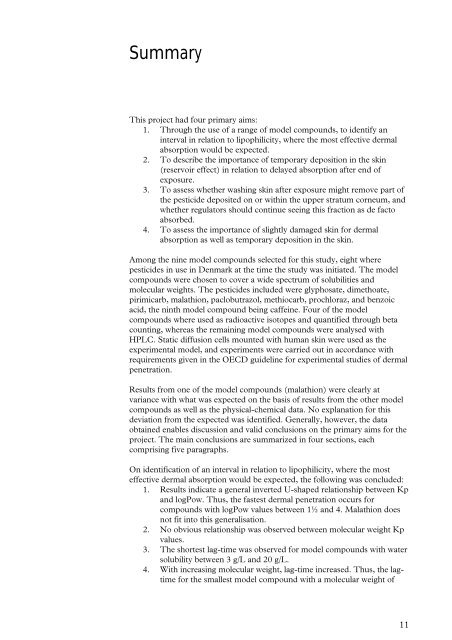PDF-format - Miljøstyrelsen
PDF-format - Miljøstyrelsen
PDF-format - Miljøstyrelsen
You also want an ePaper? Increase the reach of your titles
YUMPU automatically turns print PDFs into web optimized ePapers that Google loves.
SummaryThis project had four primary aims:1. Through the use of a range of model compounds, to identify aninterval in relation to lipophilicity, where the most effective dermalabsorption would be expected.2. To describe the importance of temporary deposition in the skin(reservoir effect) in relation to delayed absorption after end ofexposure.3. To assess whether washing skin after exposure might remove part ofthe pesticide deposited on or within the upper stratum corneum, andwhether regulators should continue seeing this fraction as de factoabsorbed.4. To assess the importance of slightly damaged skin for dermalabsorption as well as temporary deposition in the skin.Among the nine model compounds selected for this study, eight wherepesticides in use in Denmark at the time the study was initiated. The modelcompounds were chosen to cover a wide spectrum of solubilities andmolecular weights. The pesticides included were glyphosate, dimethoate,pirimicarb, malathion, paclobutrazol, methiocarb, prochloraz, and benzoicacid, the ninth model compound being caffeine. Four of the modelcompounds where used as radioactive isotopes and quantified through betacounting, whereas the remaining model compounds were analysed withHPLC. Static diffusion cells mounted with human skin were used as theexperimental model, and experiments were carried out in accordance withrequirements given in the OECD guideline for experimental studies of dermalpenetration.Results from one of the model compounds (malathion) were clearly atvariance with what was expected on the basis of results from the other modelcompounds as well as the physical-chemical data. No explanation for thisdeviation from the expected was identified. Generally, however, the dataobtained enables discussion and valid conclusions on the primary aims for theproject. The main conclusions are summarized in four sections, eachcomprising five paragraphs.On identification of an interval in relation to lipophilicity, where the mosteffective dermal absorption would be expected, the following was concluded:1. Results indicate a general inverted U-shaped relationship between Kpand logPow. Thus, the fastest dermal penetration occurs forcompounds with logPow values between 1½ and 4. Malathion doesnot fit into this generalisation.2. No obvious relationship was observed between molecular weight Kpvalues.3. The shortest lag-time was observed for model compounds with watersolubility between 3 g/L and 20 g/L.4. With increasing molecular weight, lag-time increased. Thus, the lagtimefor the smallest model compound with a molecular weight of11
















